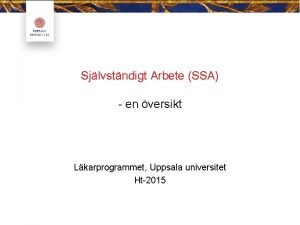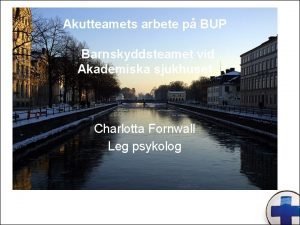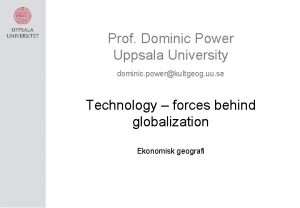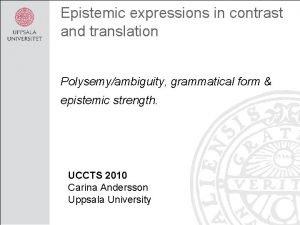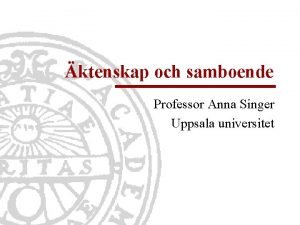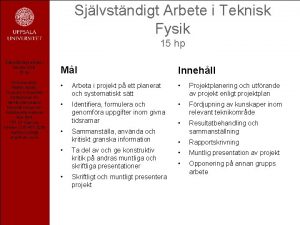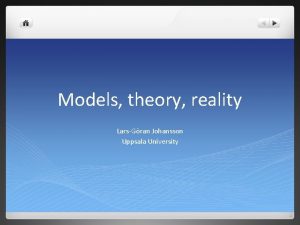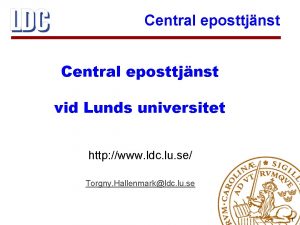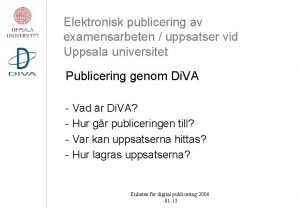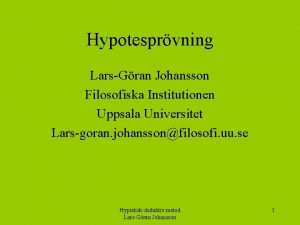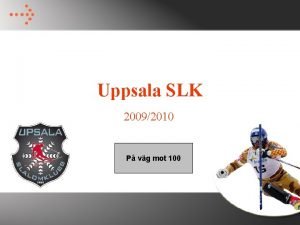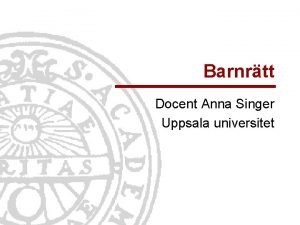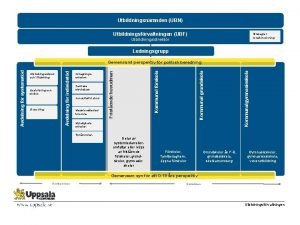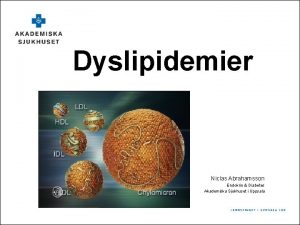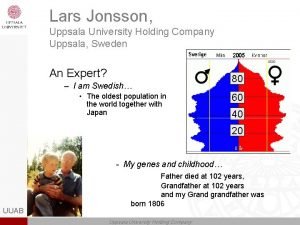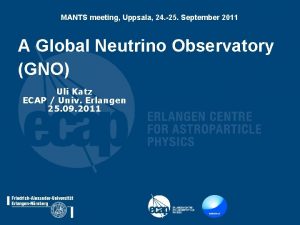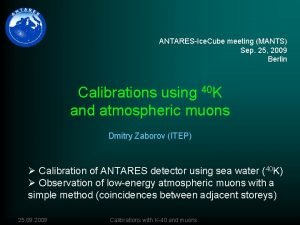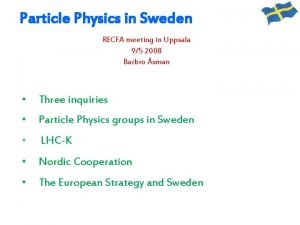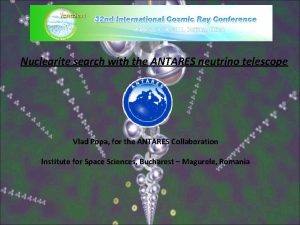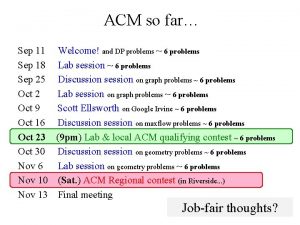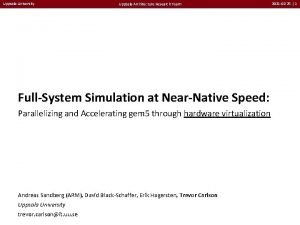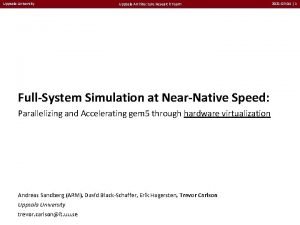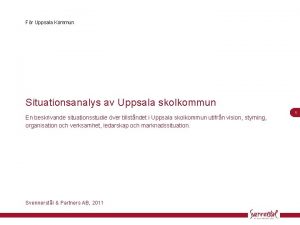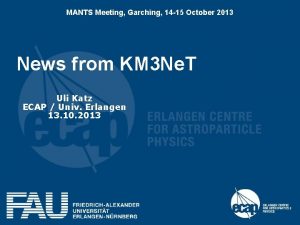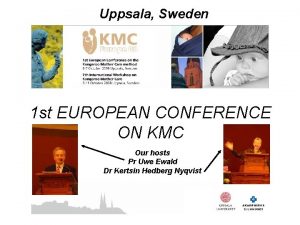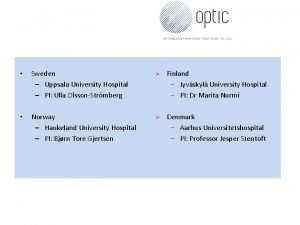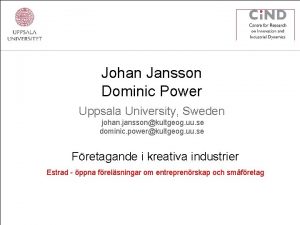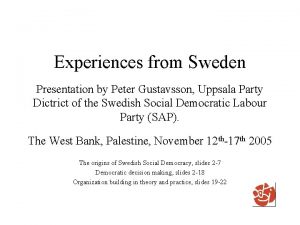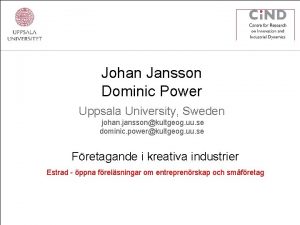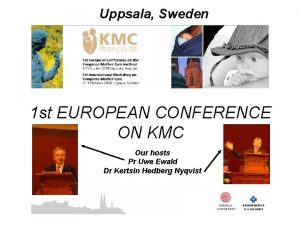MANTS Meeting Sep 24 25 Uppsala Sweden Nuclearite



























- Slides: 27

MANTS Meeting (Sep 24 - 25 -- Uppsala, Sweden) Nuclearite search with the ANTARES neutrino telescope + A short reminder on the magnetic monopoles Vlad Popa, for the ANTARES Collaboration Institute for Space Sciences, Bucharest – Magurele, Romania

Magnetic monopoles: MANTS 2010, ICRC 2011 • “Light” enough to be relativistic (M ≤ 1013 Ge. V, no proton decay catalysis) • Detectable trough Cherenkov light (direct or from δ e- ) • Search started with a blind analysis • Using the upgoing neutrino candidates (only upgoing MMs) • Based on the light yield and on β < 1 (β added as a free parameter in the reconstruction) • After unblinding the Dec. 2007 – Dec. 2008 data…


Magnetic monopoles: MANTS 2010, ICRC 2011 • “Light” enough to be relativistic (M ≤ 1013 Ge. V, no proton decay catalysis) • Detectable trough Cherenkov light (direct or from δ e- ) • Search started with a blind analysis • Using the upgoing neutrino candidates (only upgoing MMs) • Based on the light yield and on β < 1 (β added as a free parameter in the reconstruction)

Nuclearites: ICRC 2011 • “Light” enough to be relativistic (M ≤ 1013 Ge. V, no proton decay catalysis) • Detectable trough Cherenkov light (direct or from δ e- ) • Search started with a blind analysis • Using the upgoing neutrino candidates (only upgoing MMs) • Based on the light yield and on β < 1 (β added as a free parameter in the reconstruction)

Nuclearites: ICRC 2011 • Slowly moving objects (NOT relativistic) • Detectable trough Cherenkov light (direct or from δ e- ) • Search started with a blind analysis • Using the upgoing neutrino candidates (only upgoing MMs) • Based on the light yield and on β < 1 (β added as a free parameter in the reconstruction)

Nuclearites: ICRC 2011 • Slowly moving objects (NOT relativistic) • Detectable trough black body radiation • Search started with a blind analysis • Using the upgoing neutrino candidates (only upgoing MMs) • Based on the light yield and on β < 1 (β added as a free parameter in the reconstruction)

Nuclearites: ICRC 2011 • Slowly moving objects (NOT relativistic) • Detectable trough black body radiation • Search started with a blind analysis • Using the upgoing neutrino candidates (only upgoing MMs) • Based on the light yield and on β < 1 (β added as a free parameter in the reconstruction)

Nuclearites: ICRC 2011 • Slowly moving objects (NOT relativistic) • Detectable trough black body radiation • Search started with a blind analysis • Looking only for DOWNGOING nuclearites • Based on the light yield and on β < 1 (β added as a free parameter in the reconstruction)

Nuclearites: ICRC 2011 • Slowly moving objects (NOT relativistic) • Detectable trough black body radiation • Search started with a blind analysis • Looking only for DOWNGOING nuclearites • Based on the event duration

Nuclearites: basic properties E. Witten, Phys. Rev. D 30 (1984) 272 A. De Rujula, S. L. Glashow, Nature 312 (1984) 734 • Aggregates of u, d, s quarks + electrons , ne= 2/3 nu – 1/3 nd – 1/3 ns • Ground state of QCD; stable for 300 < A < 1057 r. N 3. 5 x 1014 g cm-3 nuclei 1014 g cm-3 Produced in Early Universe or in strange star collisions (J. Madsen, PRD 71 (2005) 014026) Candidates for cold Dark Matter! Searched for in CR reaching the Earth

Masses ~ Te. V: “strangelets” Electronic cloud • External electronic cloud • Easy to ionize • May be relativistic • “Nuclear” cross sections • Interactions: accretion or fragmentation? Accretion “strongly disfavored” by SLIM → cannot reach ANTRES

Masses ~ 1013 Ge. V: “nuclearites” • Most electrons inside SQM • Hard to ionize • Galactic velocities (~300 km/s) • “Atomic” cross sections • Elastic interactions with atoms Can reach ANTARES from above.

Masses > 8 1014 Ge. V: “nuclearites” • All electrons inside SQM • Electrically neutral • Galactic velocities (~300 km/s) • Mass dependent cross sections • Elastic interactions with atoms Can reach ANTARES from above. For M > 1022 Ge. V, can traverse the Earth (isotropic flux)

• Typical galactic velocities 10 -3 • Dominant interaction: elastic collisions with atoms in the medium • Dominant energy losses: • Phenomenological flux limit from the local density of DM:

Arrival conditions to the depth of ANTARES After a propagation path L in a medium, the velocity of a nuclearite of initial velocity v 0 becomes: in the atmosphere: a = 1. 2 10 -3 g cm-3; b = 8. 6 105 cm; H 50 km (T. Shibata, Prog. Theor. Phys. 57 (1977) 882. ) in water: w 1 g cm-3

Velocities in ANTARES Example for vertical incidence 2100 m 2274 m 2448 m

A little more on d. E/dx… For M 8. 4 1014 Ge. V it depends only on v 2 The passage of a nuclearite in matter produces heat along its path In transparent media some of the energy dissipated could appear as visible light (black body radiation) The “optical efficiency” = the fraction of d. E/dx appearing as light in water estimated to be = 3 10 -5 (lower bound) (A. De Ruhula, S. L. Glashow, Nature 312 (1984) 734)

Light production / cm of path Example for vertical incidence starts to increase

General strategy in ANTARES: “all data to shore”. If the charge (amplitude) is above a predefined threshold, -> “L 0” hit, buffered in a 2. 2 s window. The basic info: the “hit”: time and charge information of a photon detected by a PMT

General strategy in ANTARES: “all data to shore”. If the charge (amplitude) is above a predefined threshold, -> “L 0” hit, buffered in a 2. 2 s window. Local coincidence: “L 1”. Two L 0 hits in the same storey within 20 ns, or a single large amplitude hit (3 pe or more) The “directional trigger” (DT): at least 5 L 1 hits anywhere in the detector, within a 2. 2 s window and causally connected. “T 3 cluster”: two “L 1” hits in adjacent or next-to-adjacent storeys within 20 ns. The “cluster trigger” (CT): at least two T 3 within 2. 2 s.

General strategy in ANTARES: “all data to shore”. All PMT pulses in a 2. 2 s window conserved in a buffer, as well as the previous window. When a trigger occurs (DT or/and CT), all hits (above threshold) from the corresponding time window as well as the previous one are recorded for off-line analysis. The shortest duration of an “event” (“snapshot”) is thus 4. 4 s; as triggers could occur in the next time window, snapshots could be longer (adjacent events are merged). Nuclearites are expected to be slowly moving: should be seen as anomalously long events, or as series of consequent snapshots. The typical crossing time about 1 ms!

Nuclearite search in ANTARES, 2007 and 2008 data Data recorded during ANTARES completion Variations in the operation conditions (e. g. . new lines added) Various detector configurations (5, 9, 10 and 12 lines) Different threshold values Each configuration treated separately! Blind analysis: the search strategy defined trough Monte Carlo, validated using 15% of each data set, analysis on all data after unblinding maximized efficiency

Monte Carlo simulations Nuclearites: Chose the mass and initial velocity, compute the velocity at the entry in the simulation hemisphere, propagate in the hemisphere with time resolution of 2 ns Geometrical acceptance Events, mixed with background and processed by DT and CT triggers Efficiencies Background: -Atmospheric muons: MUPAGE (M. Bazzoti et al. , Comput. Phys. Commun, 181 (2010) 835) - Bioluminiscence, K, etc, extracted from real runs.

Selection criterion: the duration of the events, dt = tlast trigg. – tfirst trigg. Triggers optimized for relativistic particles → most simulated events produce multiple adjacent snapshots! For single snapshot events we require dt > 2 C 1 (Cut “C 2”) “C 1” cut

No event survived the C 1 (+C 2) cuts applied to 15% of the data collected during 2007 and 2008. Analysis sensitivities' obtained for all configurations.

After unblinding, data from 2007 and 2008 were analyzed. Very few events survived the cuts. Each was carefuly analized: - check of the Event Display - study of the collected charge barycenter versus time. As the light emitted by the over-heated nuclearite path is isotropic, this should describe the event topology (a first step event reconstruction). No event compatible with the down-going nuclearite predictions. All events interpretable as bioluminescent phenomena. We could derive the 90% upper flux limit for down-going nuclearites,
 Types of meeting
Types of meeting Today meeting or today's meeting
Today meeting or today's meeting Proposal kickoff meeting agenda
Proposal kickoff meeting agenda What is meeting and types of meeting
What is meeting and types of meeting Region uppsala
Region uppsala Läkarprogrammet uppsala
Läkarprogrammet uppsala Sjukanmälan katedralskolan uppsala
Sjukanmälan katedralskolan uppsala Barnskyddsteamet uppsala
Barnskyddsteamet uppsala Western union uppsala
Western union uppsala Karuselldagen uppsala
Karuselldagen uppsala Carina andersson uppsala
Carina andersson uppsala Anna singer uppsala
Anna singer uppsala Teknisk fysik uu
Teknisk fysik uu Sociologiska institutionen uppsala
Sociologiska institutionen uppsala Uppsala theory
Uppsala theory Webmail lu
Webmail lu Anders berglund uppsala
Anders berglund uppsala Uppsala universitet uppsatser
Uppsala universitet uppsatser Filosofiska institutionen uppsala
Filosofiska institutionen uppsala Scandinova uppsala
Scandinova uppsala Uppsala skidgymnasium
Uppsala skidgymnasium Gunnar enlund uppsala
Gunnar enlund uppsala Bekräfta faderskap uppsala
Bekräfta faderskap uppsala Strategisk ledningsgrupp
Strategisk ledningsgrupp Endokrin akademiska
Endokrin akademiska Sydöstra uppsala
Sydöstra uppsala Lars jonsson uppsala
Lars jonsson uppsala Olle lundin uppsala
Olle lundin uppsala





